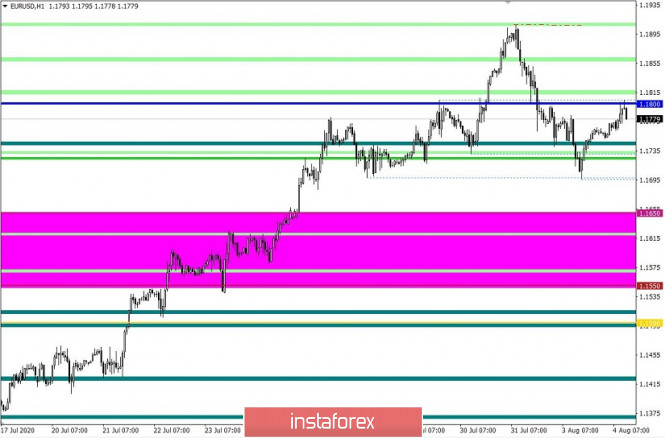
EUR/USD is making correction for the first time since early July. The price declined to nearly 1.1700 from where it rebounded a bit.
Almost 30% is a correction from the upward move of July that is considered normal in terms of regaining momentum. Nevertheless, something arouses doubts. In my earlier articles, I told you about price gyrations of EUR as the angle of a price move was 84 degrees. This is unusual price fluctuation. The facts indicated that EUR was advancing for speculative reasons. This proves an unstable nature of EUR's strength. Besides, there are no fundamentals for bullish medium- and long-term trends.
So, I expect a correction of 35-45% of the current levels, but not 20-30% as it usually happens.
Importantly, 1.1700 already triggered the struggle between bulls and bears on July 27-29. As a result, the price declined from the elevated levels.
Will EUR/USD resume the uptrend again? Everything depends on what points the price fixes relative to 1.1800. Another thing is that I predict the formation of the Head and Shoulders pattern on H1 chart. The right shoulder is the first thing to form.
Breaking down the trading day yesterday minute by minute, I see that most short positions were recorded in the period 12:00 – 16:00 when the level of 1.1700 was touched. Since then, traders rushed to open long positions in the New York trade. A flood of long deals pushed the price up to 1.1765.
The volatility index is measured at 100 that 21% higher than an average daily value. The hectic movement of EUR/USD indicates robust speculative activity on Forex.
As I said in the previous review, traders were working inside the corrective stage since Friday. The move towards 1.1700/1.1715 was expected.
Considering the daily chart, I don't find out a clear-cut correction. The price halted at the local high and formed two minor downward pin bars. Assuming the bullish momentum, the correction is yet to come.
The economic calendar yesterday featured a final manufacturing PMI for the Eurozone. The index came out to be better than expected at 51.8. Oddly enough, the market showed a muted response to the data.
In the New York trade, traders were alert to a manufacturing PMI from the ISM. The index rose to 50.9 in July from 49.8. The revised PMI undershot expectations for 51.3. Perhaps the worse-than-expected index was also to blame for the broad-based weakness of the US dollar.
On the coronavirus front, traders are worried about rampant infection rates worldwide for obvious reasons. The world is on the verge of the second pandemic wave.
President of the Federal Reserve Bank of Minneapolis Neel Kashkari believes that the US economy could have won the battle with the virus in case the authorities had imposed tough restrictive measures for 4-6 weeks. Congress could afford to allocate huge funds to contain the pandemic.
"If we were to lock down hard for a month or six weeks, we could get the case count down, so that our testing and our contact tracing was actually enough to control it," Mr Kashkari said. "If we don't do that, and we have this raging virus spreading throughout the country with flare-ups and local lockdowns for the next year or two, which is entirely possible, we're going to see many, many more business bankruptcies."
President and CEO of the Federal Reserve Bank of Dallas Robert Kaplan said in the interview to Bloomberg that he doubts that the forecast of US GDP growth from July to September 2020 will come true. The policymaker reckons the unemployment rate will climb to 9-10% by the year end.

Today the economic calendar reminds us of the PPI report for the eurozone. Factory inflation slowed down to -3.7% from -5.0% y/y. This actual figure is much better the forecast for -4.0%. Producer prices grew 0.7% m/m that is welcome news for investors.
In response to yesterday's batch of macroeconomic data, EUR extended its advance.
Later today, the US is due to release durable goods orders which are expected to contract to 5.0% from 8.0% m/m. If so, the US dollar will suffer another blow.
Further price move
Looking at the ongoing movement on the chart, the price touched 1.1800, slowed down a bit, and pulled back. Now you have to be cautious as market participants will determine a further trajectory from 1.1800 for a few days ahead.
I suggest two scenarios.
The first one is a medium-term uptrend. In case the price holds firmly above 1.1815, we will be able to plan a series of long deals. In turn, the price will make higher highs.
The second scenario is on the contrary suggests a further correction. In case of the full-fledged decline from 1.1800, the price could form the pattern Head and Shoulders. This will entail a price reversal and an extended downward correction.
Based on my speculations, I can advise the following.
-Short positions are planned from the levels below 1.1770 towards 1.1855-1.1900. The next series of deals are planned after the price fixes below 1.1690 towards 1.1650-1.1550.
-Long deals should be planned from the level higher than 1.1815 towards 1.18550-1.1900.

Indicator analysis
Having scrutinized various time frames, I see that technical indicators on one-minute and one-hour time frames signal long positions on account of the price bounce towards 1.1800. The daily chart still signals long positions as earlier.
Volatility assessment
The volatility assessment mirrors average daily fluctuations as well as on monthly terms, quarterly terms, and annual terms
Volatility is measured at 53 points at the time of writing this article that is 35% lower than an average daily level.
I predict that EUR/USD is set to trade under higher volatility in the short to medium term.
Key levels
Resistance levels: 1.1800**; 1.2000***; 1.2100*; 1.2450**
Support levels: 1.1650*; 1.1500; 1.1350; 11250*; 1.1180**; 1.1080; 1.1000***; 1.0850**; 1.0775*; 1.0650 (1.0636); 1.0500***; 1.0350**; 1.0000***
*Periodic level
**Levels of trading range
***Psychological level